



The territories of Mexico are part of the history of 19th and 20th century independent Mexico. [1] [2] The country created territories (territorios) for areas too lightly populated to be states (estados), or for political reasons.




The territories of Mexico are part of the history of 19th and 20th century independent Mexico. [1] [2] The country created territories (territorios) for areas too lightly populated to be states (estados), or for political reasons.
The 1824 Constitution of Mexico defined four territories. Seven others were created later in the 19th and early 20th centuries.
| Date | Territory | Change | Legal source |
|---|---|---|---|
| October 4, 1824 | Alta California Territory | Created | 1824 Constitution of Mexico |
| October 4, 1824 | Baja California Territory | Created | 1824 Constitution of Mexico |
| July 4, 1914 | Bravo Territory | Created from parts of Chihuahua | |
| October 4, 1824 | Colima Territory | Created | 1824 Constitution of Mexico |
| July 4, 1914 | Jiménez Territory | Created from parts of Chihuahua | |
| July 4, 1914 | Morelos Territory | Created from Morelos | |
| October 4, 1824 | Nuevo México Territory | Created | 1824 Constitution of Mexico |
| November 24, 1824 | Tlaxcala Territory | Created from parts of Puebla. | |
| May 23, 1835 | Aguascalientes Territory | Created from parts of Zacatecas. | |
| May 3, 1858 | Campeche Territory | Created from Campeche District of Yucatán. | |
| December 12, 1884 | Tepic Territory | Created from parts of Jalisco. | By decree of President Manuel González |
| January 16, 1902 | Territory of Quintana Roo | Created from part of Yucatán. | By decree of President Porfirio Díaz |
| December 30, 1930 | Territory of Baja California Norte | Created from Baja California Territory | By decree of President Pascual Ortiz Rubio |
| December 30, 1930 | Territory of Baja California Sur | Created from Baja California Territory | By decree of President Pascual Ortiz Rubio |

The History of Equatorial Guinea is marked by centuries of colonial domination by the Portuguese, British and Spanish colonial empires, and by the local kingdoms.

The United Mexican States is a federal republic composed of 32 federal entities: 31 states and Mexico City, an autonomous entity. According to the Constitution of 1917, the states of the federation are free and sovereign in all matters concerning their internal affairs. Each state has its own congress and constitution.

Torreón is a city and seat of Torreón Municipality in the Mexican state of Coahuila. As of 2021, the city's population was 735,340. The metropolitan population as of 2015 was 1,497,734, making it the ninth-biggest metropolitan area in the country and the largest metropolitan area in the state of Coahuila, as well as one of Mexico's most important economic and industrial centers. The cities of Torreón; Gómez Palacio, Durango; Lerdo, Durango; Matamoros; Francisco I. Madero; San Pedro; Bermejillo, Durango; and Tlahualilo, Durango form the area of La Laguna or the Comarca Lagunera, a basin within the Chihuahuan Desert.

Tlaxcala, officially Tlaxcala de Xicohténcatl, is the capital city of the Mexican state of Tlaxcala and seat of the municipality of the same name. The city did not exist during the pre-Hispanic period but was laid out by the Spanish as a center of evangelization and governance after the Spanish conquest of the Aztec Empire. The city was designated as a diocese but eventually lost that status to Puebla as its population declined. The city still has many of its old colonial structures, including the former Franciscan monastery, and newer civic structures like the Xicohtencatl Theatre.
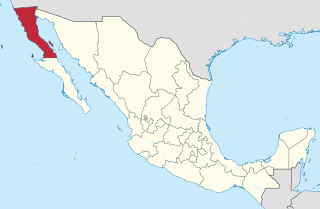
Baja California, officially Estado Libre y Soberano de Baja California, is a state in Mexico. It is the northernmost and westernmost of the 32 federal entities of Mexico. Before becoming a state in 1952, the area was known as the North Territory of Baja California. It has an area of 70,113 km2 (27,071 sq mi) and comprises the northern half of the Baja California Peninsula, north of the 28th parallel, plus oceanic Guadalupe Island. The mainland portion of the state is bordered on the west by the Pacific Ocean; on the east by Sonora, the U.S. state of Arizona, and the Gulf of California; on the north by the U.S. state of California; and on the south by Baja California Sur.

Colima, officially the Free and Sovereign State of Colima, is among the 31 states that make up the 32 Federal Entities of Mexico. It shares its name with its capital and main city, Colima.

The Nahuas are a group of the indigenous people of Mexico, El Salvador, Guatemala, Honduras, Nicaragua, and Costa Rica. They comprise the largest indigenous group in Mexico and second largest in El Salvador. They are a Mesoamerican ethnicity. The Mexica (Aztecs) are of Nahua ethnicity, as are their historical enemies, the Tlaxcallans (Tlaxcaltecs), and the Toltecs which predated both groups are often thought to have been as well, though in the pre-Columbian period Nahuas were subdivided into many groups that did not necessarily share a common identity.
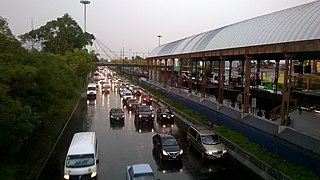
Iztacalco is a borough in Mexico City. It is located in the central-eastern area and it is the smallest of the city's boroughs. The area's history began in 1309 when the island of Iztacalco, in what was Lake Texcoco, was settled in 1309 by the Mexica who would later found Tenochtitlan, according to the Codex Xolotl. The island community would remain small and isolated through the colonial period, but drainage projects in the Valley of Mexico dried up the lake around it. The area was transformed into a maze of small communities, artificial islands called chinampas and solid farmland divided by canals up until the first half of the 20th century. Politically, the area has been reorganized several times, being first incorporated in 1862 and the modern borough coming into existence in 1929. Today, all of the canals and farmland are dried out and urbanized as the most densely populated borough and the second most industrialized.

Mexicans are the citizens and nationals of the United Mexican States.

Mexico, officially the United Mexican States, is a country in the southern portion of North America. It covers 1,972,550 km2, making it the world's 13th-largest country by area; with a population of almost 130 million, it is the 10th-most-populous country and the most populous Spanish-speaking country. Mexico is organized as a federal constitutional republic comprising 31 states and Mexico City, its capital. It shares land borders with the United States to the north, with Guatemala and Belize to the southeast; as well as maritime borders with the Pacific Ocean to the west, the Caribbean Sea to the southeast, and the Gulf of Mexico to the east.
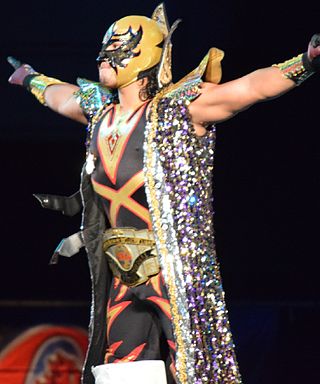
The CMLL World Welterweight Championship is a professional wrestling world championship in the Mexican professional wrestling promotion Consejo Mundial de Lucha Libre (CMLL). The official definition of the welterweight division in Mexico is between 70 kg (150 lb) and 78 kg (172 lb) but the official weight limits are not always adhered to. As with other professional wrestling championships, it is not won or lost competitively but is instead scripted by the bookers of a wrestling promotion. The title is awarded after the chosen wrestler "wins" a match.
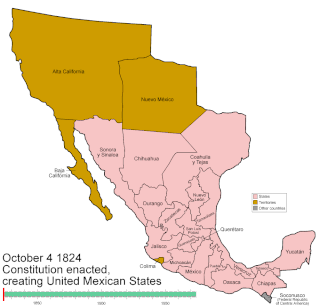
Mexico has experienced many changes in territorial organization during its history as an independent state. The territorial boundaries of Mexico were affected by presidential and imperial decrees. One such decree was the Law of Bases for the Convocation of the Constituent Congress to the Constitutive Act of the Mexican Federation, which determined the national land area as the result of integration of the jurisdictions that corresponded to New Spain, the Captaincy General of Yucatán, the Captaincy General of Guatemala and the autonomous Kingdoms of East and West. The decree resulted in the independence from Spain.

Zacatecas ( ), officially the Free and Sovereign State of Zacatecas, is one of the 31 states of Mexico. It is divided into 58 municipalities and its capital city is Zacatecas.

Condesa or La Condesa is an area in the Cuauhtémoc Borough of Mexico City, south of Zona Rosa and 4 to 5 km west of the Zócalo, the city's main square. It is immediately west of Colonia Roma, together with which it is designated as a "Barrio Mágico Turístico". Together they are often referred to as Condesa–Roma, one of the most architecturally significant and bastion of the creative communities of the city.

The Spanish diaspora consists of Spanish people and their descendants who emigrated from Spain. In the Americas, the term may refer to those of Spanish nationality living there; "Hispanic" is usually a more appropriate term to describe the general Spanish-speaking populations of the Americas together with those in Spain. The diaspora is concentrated in places that were part of the Spanish Empire. Countries with sizeable populations are Argentina, Bolivia, Chile, Colombia, Costa Rica, Cuba, Dominican Republic, Ecuador, El Salvador, Guatemala, Honduras, Mexico, Nicaragua, Panama, Paraguay, Peru, Uruguay, Venezuela, and, to a lesser extent, Brazil, Belize, Haiti, United States, Canada, the Philippines and the rest of Europe.
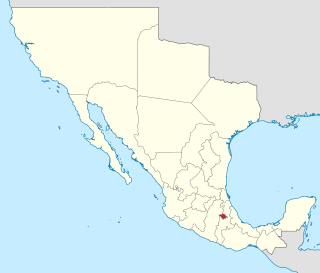
Tlaxcala Territory was a territory of Mexico, from 1824 to 1857. The capital was Tlaxcala City.

Lebanese Mexicans refers to Mexican citizens of Lebanese origin.

The Territory of Quintana Roo was a federal territory of Mexico that existed intermittently between 1902 and 1974, when it was granted statehood within the United Mexican States as Quintana Roo.
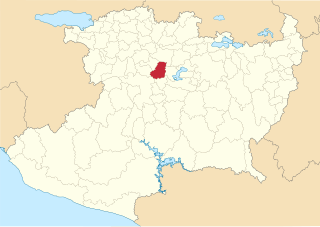
Nahuatzen is a municipality in the Mexican state of Michoacán. It is located approximately 75 kilometres (47 mi) west of the state capital of Morelia.